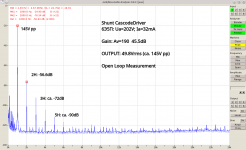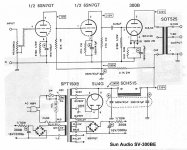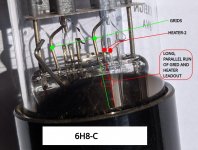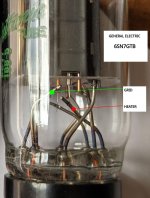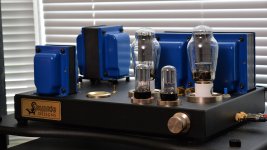I agree with you, Rod. I have tried pentode connected 6SJ7, cascoded 6SN7, 6C45P, triode connected 6E5P and pentode connected EL84, with the latter sounding best of all.
I'm still seeking for a potential better driver. Candidates are: triode connected 6J9P, triode connected EL84 and triode connected D3A.
The pentode driver is very good. Even the EF80 is nice, for VG2=150V; Ik = 14mA. It likes a quiet power supply. I used the EL84 & 6BW7 in pentode as a reference for developing my own 300B driver.
The target spec.: lower distortion at 50Vrms (150Vpp); no stress on the power supply at overload; low input capacitance and high gain from a single stage. The 6Э5П (6E5P) in my Shunt Cascode design is the best sounding - and measuring - so far...
I used the EL84 & 6BW7 in pentode as a reference for developing my own 300B driver.
What is your own (currently) 300B driver?
The 6Э5П (6E5P) in my Shunt Cascode design is the best sounding - and measuring - so far...
Can you elaborate more in this? I would be interested in trying the 6E5P in a driver stage that sounds more than adequate...
> What is your own (currently) 300B driver?
It's my Shunt Cascode design.
Here it is, with the open-loop measurements at 145V pp. see how the cadence of harmonics is gradual, and natural. It sounds as good as these readings suggest!
The gain is 190, so it runs as a single stage, directly from a DAC (the capacitance is very low too).
The high gain means it needs a carefully laid-out circuit board, but it need that for the regulated voltages, anyway.
It also needs a servo, unless you don't mind occasional readjusting.
I am working through the tests on a new PCB with all these features, and a few more, right now.
It's my Shunt Cascode design.
Here it is, with the open-loop measurements at 145V pp. see how the cadence of harmonics is gradual, and natural. It sounds as good as these readings suggest!
The gain is 190, so it runs as a single stage, directly from a DAC (the capacitance is very low too).
The high gain means it needs a carefully laid-out circuit board, but it need that for the regulated voltages, anyway.
It also needs a servo, unless you don't mind occasional readjusting.
I am working through the tests on a new PCB with all these features, and a few more, right now.
Attachments
It's my Shunt Cascode design. I am working through the tests on a new PCB with all these features, and a few more, right now.
Any idea when you will be able to make the PCB available to us? I imagine a few people would want to build it. What kind of measures have you taken to eliminate oscillation on the 6e5? I know you've talked about this in the past and a search would bring up some guidelines, but wondering what your latest thinking is and how it would fit on a pcb.
300B amp based on the classic JC Morrison 6SN7
JC published a small pamphlet of schematics back in the 1990s in a plastic folder. I don't know where my copy is at the moment, but as I recall it was a combination of a few USA domestic PP schematics along with several Japanese ones from the 1970s and 1980s. One of the schematics in that folder was the Sun Audio SV-300BE.
Attachments
> The Russian 6H8C is a great sounding equal of a 6SN7GT
The 6H8-C is nominally an equivalent to the 6SN7, but I would not call it an equal. I compared them to the GE and Sylvania when I built the Morrison design in the 1990s, and apart from the difference in sound, the 6H8-C runs the internal conductors of grids and heaters much closer - enough to cause hum in some samples; I am not picking holes in something I haven't tried.
I just got this amp finished tonight and am burning things in. Tossed a pair of 6H8C tubes in and they are dead silent, like the whole amp is. Zero hum. I can only speculate that maybe you didn't have the heaters set with 35V DC offset, which given one of the cathodes is running at 70V, if it was referenced to ground that might do it or possibly was a lead dress issue?
Like I said, just got it running and plan to tune the circuit some (seems a tad bright to my taste) but overall, it sounds nice to me using even these cheap tubes. Then again I'm not running this amp with $35K speakers through $2000 speaker cables, with a $5000 power regenerator so there is that.
0.22uF decoupling - you could increase that, say 2x0.22 or 0.33uF.
I was thinking about trying that given the size of the 300B grid leak resistor, thanks for the tip. I also want to play with using an LED + small resistor on the cathode of the first stage, that's worked well for me in other amplifiers. I can also see a small amount of local NFB being useful with these transformers. I want to see how good I can get it to sound with these cheap EH tubes using 6H8C for the driver tubes, budget build and all that 🙂
> I just got this amp finished tonight and am burning things in. Tossed a pair of 6H8C tubes in and they are dead silent, like the whole amp is. Zero hum. I can only speculate that maybe you didn't have the heaters set with 35V DC offset, which given one of the cathodes is running at 70V, if it was referenced to ground that might do it or possibly was a lead dress issue?
Bias voltage on the heaters addresses problems of thermionic leakage between heater and cathode. It has no effect on direct EM-coupling from heater-to-grid, which is the weakness I noted with the 6H8-C.
The flaw with the 6N8-C is the dress of the lead-outs internally, with the grid running close to the heater in their design.
The photos show a comparison of a couple of samples from my hoard.
On the left is the 6H8, showing in detail the questionable lead routing. Notice how the two sides have different routing, and different gaps from Grid to Heater. This is no surprise - they were hand-assembled. Some of them are OK, some of them are markedly worse.
The other pic is of the internals of a GE 6SN7 - no worries about Grid-Heater lead-out with these. Note also the GE's grid supports are copper - better grid-cooling, to avoid the risk of grid emission.
The Soviets produced some good valves later, especially the TFK-based designs, and their original-design frame-grid valves. But the 6H8-C was not in the same league as one of those.
Bias voltage on the heaters addresses problems of thermionic leakage between heater and cathode. It has no effect on direct EM-coupling from heater-to-grid, which is the weakness I noted with the 6H8-C.
The flaw with the 6N8-C is the dress of the lead-outs internally, with the grid running close to the heater in their design.
The photos show a comparison of a couple of samples from my hoard.
On the left is the 6H8, showing in detail the questionable lead routing. Notice how the two sides have different routing, and different gaps from Grid to Heater. This is no surprise - they were hand-assembled. Some of them are OK, some of them are markedly worse.
The other pic is of the internals of a GE 6SN7 - no worries about Grid-Heater lead-out with these. Note also the GE's grid supports are copper - better grid-cooling, to avoid the risk of grid emission.
The Soviets produced some good valves later, especially the TFK-based designs, and their original-design frame-grid valves. But the 6H8-C was not in the same league as one of those.
Attachments
Any idea when you will be able to make the PCB available to us? I imagine a few people would want to build it. What kind of measures have you taken to eliminate oscillation on the 6e5? I know you've talked about this in the past and a search would bring up some guidelines, but wondering what your latest thinking is and how it would fit on a pcb.
The 6E5P can be used in most circuits with only a grid-stopper to suppress oscillation.
But with Shunt Cascode the gain can easily be x200 or even higher, In this case, the wiring linked to grid, and to anode, must be as compact as possible. The Shunt Cascode also requires a current-source in the anode circuit, and that too must be designed for good HF behaviour, tightly arranged, and with short conductors.
So the new board has all these considerations addressed, and the new features. It has a new design of anode-supply regulator which is already giving good performance: very low drift, and low noise and 1/f corner.
I don't like to hurry the design-testing, so it will probably be September before they can be let loose.
I just got this amp finished tonight and am burning things in. Tossed a pair of 6H8C tubes in and they are dead silent, like the whole amp is. Zero hum. ... plan to tune the circuit some (seems a tad bright to my taste) but overall, it sounds nice to me using even these cheap tubes. ...
Congrats on a hum-free build! I enjoyed the video series. That trick of mounting the terminal strips over the chassis-mounted ss rectifiers is a good one. I need to remember that.
Just my two cents, but maybe give those new tubes a week or two of regular use before tuning the amp.
Looking forward to more build videos from you.
cheers, Derek
The Soviets produced some good valves later, especially the TFK-based designs, and their original-design frame-grid valves. But the 6H8-C was not in the same league as one of those.
The pair I have sound fine in two different amps, not sure why you had problems.
Just my two cents, but maybe give those new tubes a week or two of regular use before tuning the amp.
Looking forward to more build videos from you.
That's a very good point. These probably do need more burn-in time than some other types. What should I expect to hear as they burn in?
I think my next series is going to be on a pair of ST35 based monoblocks 🙂
The pair I have sound fine in two different amps, not sure why you had problems.
I do, and I explained it in detail.
If you are satisfied, fine, enjoy them.
But it does not make them a good design, or the sample to sample variation any less wide.
... What should I expect to hear as they burn in?
No experience with those particular tubes, but my experience is that the sound of new tubes changes with initial use. Just anecdotal, but my EML 45B tubes are illustrative of my experience. With first use (as a straight drop in for regular 45s), I found them grainy sounding and lifeless. I much preferred my NOS and OS 45 tubes. That didn't change much over the next 25 hrs or so, and I pretty much gave up on the EML 45Bs. I started using them when breaking in new caps and iron b/c I didn't want use up the lifetime of any of my "good" 45s. During the break-in time I didn't listen to the amp and instead ran it with dummy load resistors on the speaker outs. 100+ hrs later I gave the amp a listen without switching back to my regular 45s. It sounded great. So I figured it would sound even better with the "good" 45s. Nope. The EML 45Bs now sounded better. I had about 5 pairs of NOS and OS 45s, and tried them all. To my ears the burned-in EML 45Bs beat them all.
Not saying that this will be your experience, but it's worth a shot.
I think my next series is going to be on a pair of ST35 based monoblocks 🙂
Cool. Looking forward to it.
cheers, Derek
Final build pictures
I wanted to upload a couple of pictures of the finished amp. Right now I am letting it burn in, but it sounds really good just following the JC schematic + regulated heaters. I plan to play around with a variety of mods but wanted to let everything settle in for a week or so, plus do some tube rolling. The 300B is running at 360V across it at 80ma, which it should have a long life living there.
The total cost came in just under $900 all in, with all new parts including the tubes. The only way I can see to reduce the cost further would be to go with AC heaters or go for used parts. I already had this iron from a KT88 SE build I did, so I ended up with less than $500 including a new chassis.
I wanted to upload a couple of pictures of the finished amp. Right now I am letting it burn in, but it sounds really good just following the JC schematic + regulated heaters. I plan to play around with a variety of mods but wanted to let everything settle in for a week or so, plus do some tube rolling. The 300B is running at 360V across it at 80ma, which it should have a long life living there.
The total cost came in just under $900 all in, with all new parts including the tubes. The only way I can see to reduce the cost further would be to go with AC heaters or go for used parts. I already had this iron from a KT88 SE build I did, so I ended up with less than $500 including a new chassis.
Attachments
Stephe -- Maybe I missed it the videos, but what are those rings around the tube sockets? Where did you get them? How are they attached to the chassis?
I like the look of them. Might help hide my less than perfectly circular vent holes.
cheers and thanks, Derek
I like the look of them. Might help hide my less than perfectly circular vent holes.
cheers and thanks, Derek
Stephe -- Maybe I missed it the videos, but what are those rings around the tube sockets? Where did you get them? How are they attached to the chassis?
I like the look of them. Might help hide my less than perfectly circular vent holes.
cheers and thanks, Derek
I bought them from Tube Shield Ring Washer
They bolt in from underneath though small holes drilled in the chassis and also hold the tube socket in place. I think they look great and give the amp a clean look.
Awesome. many thanks. I'm going to get some.
I also buy my knobs from them, you can see the ones that match that gold color, and they also have silver in a variety of styles. I've bought tubes from them too, good service.
- Home
- Amplifiers
- Tubes / Valves
- Budget 300B Build Video Series
